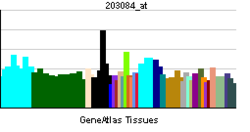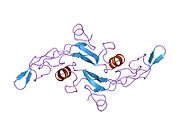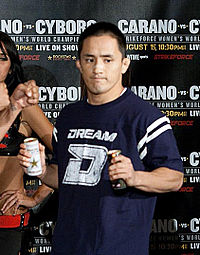TGF 베타 1
TGF beta 1변환성장인자 베타 1 또는 TGF-β1은 사이토카인의 변환성장인자 베타 슈퍼패밀리의 폴리펩타이드 성분이다.세포 성장 제어, 세포 증식, 세포 분화, 세포 사멸 등 많은 세포 기능을 수행하는 분비 단백질이다.인간에서 TGF-β1은 TGFB1 유전자에 의해 암호화된다.[5][6]
함수
TGF-β는 다기능 펩타이드 세트로 증식, 분화 및 많은 세포 유형의 다른 기능을 제어한다.TGF-β는 변환 유도에서 성장인자-알파(TGF-α) 변환과 시너지 작용을 한다.음의 자분비 성장인자 역할도 한다.TGF-β 활성화와 신호의 조절이 잘못되면 사멸을 초래할 수 있다.많은 세포들이 TGF-β를 합성하며 거의 모든 세포들이 이 펩타이드에 대한 특정 수용체를 가지고 있다.TGF-β1, TGF-β2, TGF-β3는 모두 동일한 수용체 신호 시스템을 통해 기능한다.[7]
TGF-β1은 인간 혈소판에서 상처 치유에 잠재적인 역할을 하는 25킬로달톤의 분자 질량을 가진 단백질로 처음 확인되었다.[8]후에 112개의 아미노산의 성숙한 펩타이드 생산을 위해 단백질 분해로 가공된 큰 단백질 전구체(아미노산 390개 포함)로 특징지어졌다.[9]
TGF-β1은 면역체계를 제어하는 데 중요한 역할을 하며, 다른 종류의 세포, 즉 다른 발달 단계에서 다른 활동을 보여준다.대부분의 면역세포(또는 백혈구)는 TGF-β1을 분비한다.[10]
T세포
일부 T세포(예: 규제 T세포)는 다른 T세포의 작용을 억제하기 위해 TGF-β1을 방출한다.구체적으로 TGF-β1은 활성 T세포에서 인터루킨(IL)-1- & 인터루킨-2 의존 증식을 방지하고,[11][12] 대기 도우미 T세포와 세포독성 T세포의 활성화를 방지한다.[13][14]마찬가지로, TGF-β1은 인터페론-알파, 종양 괴사 인자-알파(TNF-α), 그리고 다양한 인터루킨을 포함한 많은 다른 사이토카인의 분비 및 활동을 억제할 수 있다.또한 IL-2 수용체와 같은 사이토카인 수용체의 발현 수준을 낮춰 면역세포의 활동을 하향 조절할 수도 있다.그러나 TGF-β1은 특히 세포가 미성숙할 경우 T세포의 특정 사이토카인의 발현을 증가시키고 그 증식을 촉진시킬 수 있다.[15][10]
B세포
TGF-β1은 또한 세포의 분화 상태에 따라 변화하는 B세포에도 유사한 영향을 미친다.증식을 억제하고 B세포의 세포사멸을 자극하며 미성숙하고 성숙한 B세포에 대한 항체, 트랜스퍼린, MHC급 II 단백질의 발현을 조절한다.[16][10][16]
골수 세포
TGF-β1이 대식세포와 단세포에 미치는 영향은 대부분 억제적이다; 이 사이토카인은 이러한 세포의 확산을 억제하고 활성산소(O2−)와 질소(NO) 중간체의 생산을 막을 수 있다.그러나 다른 세포 유형과 마찬가지로 TGF-β1은 골수성 원소의 세포에도 정반대의 영향을 미칠 수 있다.예를 들어 TGF-β1은 특정 병원균에 대한 면역 반응을 유도하는 화학작용을 한다.마찬가지로 대식세포와 단세포는 화학적 방법으로 낮은 수준의 TGF-β1에 반응한다.나아가 단세포 사이토카인(IL)-1α, IL-1β, TNF-α 등)[14]의 발현과 대식세포의 판상세포는 TGF-β1의 작용으로 증가시킬 수 있다.[10]
TGF-β1은 아스트로시테스 및 덴드리트 세포에서 MHC II의 효능을 감소시키며, 이는 결국 적절한 도우미 T세포 집단의 활성화를 감소시킨다.[17][18]
상호작용
TGF 베타 1은 다음과 상호 작용하는 것으로 나타났다.
참조
- ^ a b c GRCh38: 앙상블 릴리스 89: ENSG00000105329 - 앙상블, 2017년 5월
- ^ a b c GRCm38: 앙상블 릴리스 89: ENSMUSG00000002603 - 앙상블, 2017년 5월
- ^ "Human PubMed Reference:". National Center for Biotechnology Information, U.S. National Library of Medicine.
- ^ "Mouse PubMed Reference:". National Center for Biotechnology Information, U.S. National Library of Medicine.
- ^ Ghadami M, Makita Y, Yoshida K, Nishimura G, Fukushima Y, Wakui K, Ikegawa S, Yamada K, Kondo S, Niikawa N, Tomita Ha (January 2000). "Genetic mapping of the Camurati-Engelmann disease locus to chromosome 19q13.1-q13.3". Am. J. Hum. Genet. 66 (1): 143–7. doi:10.1086/302728. PMC 1288319. PMID 10631145.
- ^ Vaughn SP, Broussard S, Hall CR, Scott A, Blanton SH, Milunsky JM, Hecht JT (May 2000). "Confirmation of the mapping of the Camurati-Englemann locus to 19q13. 2 and refinement to a 3.2-cM region". Genomics. 66 (1): 119–21. doi:10.1006/geno.2000.6192. PMID 10843814.
- ^ "Entrez Gene: TGFB1 transforming growth factor, beta 1".
{{cite web}}: CS1 maint : url-status (링크) - ^ Assoian RK, Komoriya A, Meyers CA, Miller DM, Sporn MB (1983). "Transforming growth factor-beta in human platelets. Identification of a major storage site, purification, and characterization". J. Biol. Chem. 258 (11): 7155–60. doi:10.1016/S0021-9258(18)32345-7. PMID 6602130.
- ^ Derynck R, Jarrett JA, Chen EY, Eaton DH, Bell JR, Assoian RK, Roberts AB, Sporn MB, Goeddel DV (1985). "Human transforming growth factor-beta complementary DNA sequence and expression in normal and transformed cells". Nature. 316 (6030): 701–5. Bibcode:1985Natur.316..701D. doi:10.1038/316701a0. PMID 3861940. S2CID 4245501.
- ^ a b c d Letterio JJ, Roberts AB (1998). "Regulation of immune responses by TGF-beta". Annu. Rev. Immunol. 16: 137–61. doi:10.1146/annurev.immunol.16.1.137. PMID 9597127.
- ^ Wahl SM, Hunt DA, Wong HL, Dougherty S, McCartney-Francis N, Wahl LM, Ellingsworth L, Schmidt JA, Hall G, Roberts AB (1988). "Transforming growth factor-beta is a potent immunosuppressive agent that inhibits IL-1-dependent lymphocyte proliferation". J. Immunol. 140 (9): 3026–32. PMID 3129508.
- ^ Tiemessen MM, Kunzmann S, Schmidt-Weber CB, Garssen J, Bruijnzeel-Koomen CA, Knol EF, van Hoffen E (2003). "Transforming growth factor-beta inhibits human antigen-specific CD4+ T cell proliferation without modulating the cytokine response". Int. Immunol. 15 (12): 1495–504. doi:10.1093/intimm/dxg147. PMID 14645158.
- ^ Gilbert KM, Thoman M, Bauche K, Pham T, Weigle WO (1997). "Transforming growth factor-beta 1 induces antigen-specific unresponsiveness in naive T cells". Immunol. Invest. 26 (4): 459–72. doi:10.3109/08820139709022702. PMID 9246566.
- ^ a b Wahl SM, Wen J, Moutsopoulos N (2006). "TGF-beta: a mobile purveyor of immune privilege". Immunol. Rev. 213: 213–27. doi:10.1111/j.1600-065X.2006.00437.x. PMID 16972906. S2CID 84309271.
- ^ Zhu H, Wang Z, Yu J, Yang X, He F, Liu Z, Che F, Chen X, Ren H, Hong M, Wang J (March 2019). "Role and mechanisms of cytokines in the secondary brain injury after intracerebral hemorrhage". Prog. Neurobiol. 178: 101610. doi:10.1016/j.pneurobio.2019.03.003. PMID 30923023. S2CID 85495400.
- ^ a b Lebman DA, Edmiston JS (1999). "The role of TGF-beta in growth, differentiation, and maturation of B lymphocytes". Microbes Infect. 1 (15): 1297–304. doi:10.1016/S1286-4579(99)00254-3. PMID 10611758.
- ^ Rodríguez LS, Narváez CF, Rojas OL, Franco MA, Ángel J (2012-01-01). "Human myeloid dendritic cells treated with supernatants of rotavirus infected Caco-2 cells induce a poor Th1 response". Cellular Immunology. 272 (2): 154–61. doi:10.1016/j.cellimm.2011.10.017. PMID 22082567.
- ^ Dong Y, Tang L, Letterio JJ, Benveniste EN (July 2001). "The Smad3 protein is involved in TGF-beta inhibition of class II transactivator and class II MHC expression". Journal of Immunology. 167 (1): 311–9. doi:10.4049/jimmunol.167.1.311. PMID 11418665.
- ^ Hildebrand A, Romarís M, Rasmussen LM, Heinegård D, Twardzik DR, Border WA, Ruoslahti E (September 1994). "Interaction of the small interstitial proteoglycans biglycan, decorin and fibromodulin with transforming growth factor beta". Biochem. J. 302 (2): 527–34. doi:10.1042/bj3020527. PMC 1137259. PMID 8093006.
- ^ Schönherr E, Broszat M, Brandan E, Bruckner P, Kresse H (July 1998). "Decorin core protein fragment Leu155-Val260 interacts with TGF-beta but does not compete for decorin binding to type I collagen". Arch. Biochem. Biophys. 355 (2): 241–8. doi:10.1006/abbi.1998.0720. PMID 9675033.
- ^ Takeuchi Y, Kodama Y, Matsumoto T (Dec 1994). "Bone matrix decorin binds transforming growth factor-beta and enhances its bioactivity". J. Biol. Chem. 269 (51): 32634–8. doi:10.1016/S0021-9258(18)31681-8. PMID 7798269.
- ^ Choy L, Derynck R (November 1998). "The type II transforming growth factor (TGF)-beta receptor-interacting protein TRIP-1 acts as a modulator of the TGF-beta response". J. Biol. Chem. 273 (47): 31455–62. doi:10.1074/jbc.273.47.31455. PMID 9813058.
- ^ Saharinen J, Keski-Oja J (August 2000). "Specific sequence motif of 8-Cys repeats of TGF-beta binding proteins, LTBPs, creates a hydrophobic interaction surface for binding of small latent TGF-beta". Mol. Biol. Cell. 11 (8): 2691–704. doi:10.1091/mbc.11.8.2691. PMC 14949. PMID 10930463.
- ^ Ebner R, Chen RH, Lawler S, Zioncheck T, Derynck R (November 1993). "Determination of type I receptor specificity by the type II receptors for TGF-beta or activin". Science. 262 (5135): 900–2. Bibcode:1993Sci...262..900E. doi:10.1126/science.8235612. PMID 8235612.
- ^ Oh SP, Seki T, Goss KA, Imamura T, Yi Y, Donahoe PK, Li L, Miyazono K, ten Dijke P, Kim S, Li E (March 2000). "Activin receptor-like kinase 1 modulates transforming growth factor-beta 1 signaling in the regulation of angiogenesis". Proc. Natl. Acad. Sci. U.S.A. 97 (6): 2626–31. Bibcode:2000PNAS...97.2626O. doi:10.1073/pnas.97.6.2626. PMC 15979. PMID 10716993.
- ^ McGonigle S, Beall MJ, Feeney EL, Pearce EJ (February 2001). "Conserved role for 14-3-3epsilon downstream of type I TGFbeta receptors". FEBS Lett. 490 (1–2): 65–9. doi:10.1016/s0014-5793(01)02133-0. PMID 11172812. S2CID 84710903.
추가 읽기
- Border WA, Noble NA (1994). "Transforming growth factor beta in tissue fibrosis". N. Engl. J. Med. 331 (19): 1286–92. doi:10.1056/NEJM199411103311907. PMID 7935686.
- Munger JS, Harpel JG, Gleizes PE, Mazzieri R, Nunes I, Rifkin DB (1997). "Latent transforming growth factor-beta: structural features and mechanisms of activation". Kidney Int. 51 (5): 1376–82. doi:10.1038/ki.1997.188. PMID 9150447.
- Iozzo RV (1999). "The biology of the small leucine-rich proteoglycans. Functional network of interactive proteins". J. Biol. Chem. 274 (27): 18843–6. doi:10.1074/jbc.274.27.18843. PMID 10383378.
- Reinhold D, Wrenger S, Kähne T, Ansorge S (1999). "HIV-1 Tat: immunosuppression via TGF-beta1 induction". Immunol. Today. 20 (8): 384–5. doi:10.1016/S0167-5699(99)01497-8. PMID 10431160.
- Yamada Y (2001). "Association of polymorphisms of the transforming growth factor-beta1 gene with genetic susceptibility to osteoporosis". Pharmacogenetics. 11 (9): 765–71. doi:10.1097/00008571-200112000-00004. PMID 11740340.
- Chen W, Wahl SM (2002). "TGF-β: Receptors, Signaling Pathways and Autoimmunity". TGF-beta: receptors, signaling pathways and autoimmunity. Curr. Dir. Autoimmun. Current Directions in Autoimmunity. Vol. 5. pp. 62–91. doi:10.1159/000060548. ISBN 978-3-8055-7308-5. PMID 11826761.
- Marone M, Bonanno G, Rutella S, Leone G, Scambia G, Pierelli L (2002). "Survival and cell cycle control in early hematopoiesis: role of bcl-2, and the cyclin dependent kinase inhibitors P27 and P21". Leuk. Lymphoma. 43 (1): 51–7. doi:10.1080/10428190210195. PMID 11908736. S2CID 28490341.
- Schnaper HW, Hayashida T, Hubchak SC, Poncelet AC (2003). "TGF-beta signal transduction and mesangial cell fibrogenesis". Am. J. Physiol. Renal Physiol. 284 (2): F243–52. doi:10.1152/ajprenal.00300.2002. PMID 12529270. S2CID 17046094.
- Kalluri R, Neilson EG (2003). "Epithelial-mesenchymal transition and its implications for fibrosis". J. Clin. Invest. 112 (12): 1776–84. doi:10.1172/JCI20530. PMC 297008. PMID 14679171.
- Grainger DJ (2004). "Transforming growth factor beta and atherosclerosis: so far, so good for the protective cytokine hypothesis". Arterioscler. Thromb. Vasc. Biol. 24 (3): 399–404. doi:10.1161/01.ATV.0000114567.76772.33. PMID 14699019.
- Attisano L, Labbé E (2004). "TGFbeta and Wnt pathway cross-talk". Cancer Metastasis Rev. 23 (1–2): 53–61. doi:10.1023/A:1025811012690. PMID 15000149. S2CID 41685620.
- McGowan TA, Zhu Y, Sharma K (2004). "Transforming growth factor-beta: a clinical target for the treatment of diabetic nephropathy". Curr. Diab. Rep. 4 (6): 447–54. doi:10.1007/s11892-004-0055-z. PMID 15539010. S2CID 45122439.
- Sheppard D (2005). "Integrin-mediated activation of latent transforming growth factor beta". Cancer Metastasis Rev. 24 (3): 395–402. doi:10.1007/s10555-005-5131-6. PMID 16258727. S2CID 1929903.
- Gressner AM, Weiskirchen R (2006). "Modern pathogenetic concepts of liver fibrosis suggest stellate cells and TGF-beta as major players and therapeutic targets". J. Cell. Mol. Med. 10 (1): 76–99. doi:10.1111/j.1582-4934.2006.tb00292.x. PMC 3933103. PMID 16563223.
- Seoane J (2006). "Escaping from the TGFbeta anti-proliferative control". Carcinogenesis. 27 (11): 2148–56. doi:10.1093/carcin/bgl068. PMID 16698802.
- Lee CG, Kang HR, Homer RJ, Chupp G, Elias JA (2006). "Transgenic modeling of transforming growth factor-beta(1): role of apoptosis in fibrosis and alveolar remodeling". Proc Am Thorac Soc. 3 (5): 418–23. doi:10.1513/pats.200602-017AW. PMC 2658706. PMID 16799085.
- Wahl SM (2007). "Transforming growth factor-beta: innately bipolar". Curr. Opin. Immunol. 19 (1): 55–62. doi:10.1016/j.coi.2006.11.008. PMID 17137775.
- Redondo S, Santos-Gallego CG, Tejerina T (2007). "TGF-beta1: a novel target for cardiovascular pharmacology". Cytokine Growth Factor Rev. 18 (3–4): 279–86. doi:10.1016/j.cytogfr.2007.04.005. PMID 17485238.
- Ren H, Han R, Chen X, Liu X, Wan J, Wang L, Yang X, Wang J (May 2020). "Potential therapeutic targets for intracerebral hemorrhage-associated inflammation: An update". J Cereb Blood Flow Metab. 40 (9): 1752–1768. doi:10.1177/0271678X20923551. PMC 7446569. PMID 32423330. S2CID 218689863.
외부 링크












